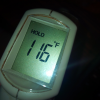mods seem to do a very good job of measuring resistance. I have done comparisons with a stand alone ohm meter. Then the challenge is can they measure resistance many times per second. Apparently they can. I'm especially confident about this now that i can see the process happening more or less real time, comparing the peak watts and temp after each puff is instructive. In my situation using an old fashoined rda the main influence seems to be the amount of liquid in contact with the coil. I see predictable behavior as the coil gets less saturated. But the theme here is, how to stay below 470 F. So far that doesn't seem so hard to do unless your hobby is pushing things until they break.I would be interested to know just how accurate the resistance readings on on any of the TC mods are.
I have spent the last decade or so calibrating test equipment, I can't think of many bits of kit that are able to accurately measure low resistance quickly (multiple times a second) and accurately (to within 0.001 ohms) None of them would come in at the price point of even the high end TC boards. If Evolve or any of the other manufacturers have cracked it then they should move into selling test equipment when the FDA closes them down.....
Last edited:



 and has been instantly cooled due to the tiny air flow it has or its not hitting high temps. Which is it and why is it so hard for scientist to accuratly test these things with all the equipment they have?? Are they really looking for the truth? It seems like the only people that are looking for the truth are people in this thread with a serious lack of equipment and a lab.... (and me personally, a Science degree)
and has been instantly cooled due to the tiny air flow it has or its not hitting high temps. Which is it and why is it so hard for scientist to accuratly test these things with all the equipment they have?? Are they really looking for the truth? It seems like the only people that are looking for the truth are people in this thread with a serious lack of equipment and a lab.... (and me personally, a Science degree)


